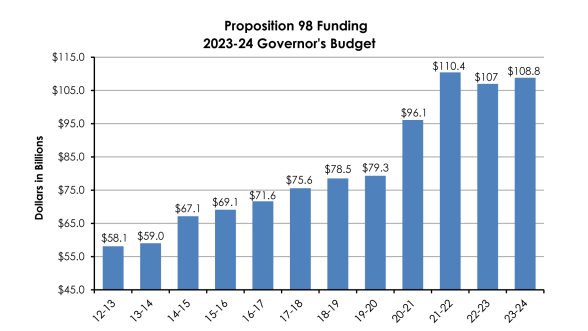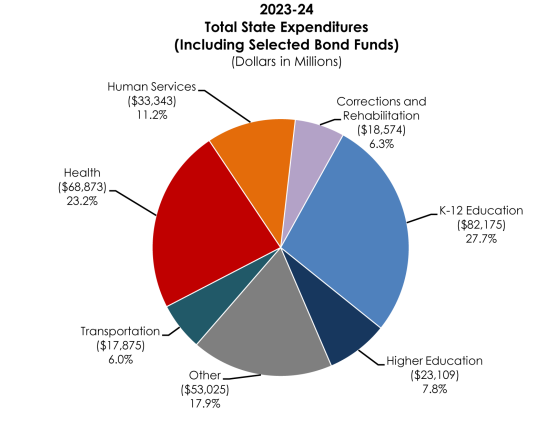
Table of Contents
The decline in revenue is poised to significantly impact school spending in California.
In the recent Fiscal Outlook by The Legislative Analyst’s Office for the state, it was disclosed that a severe revenue drop in 2022-23 has resulted in a substantial budget deficit of $68 billion. According to current state law and policy, the Legislature must address this deficit in the upcoming budget process.
To address the budget shortfall, California Governor Gavin Newsom could opt to declare a fiscal emergency, granting access to $24 billion from previously accumulated budget surpluses. While this provides a short-term infusion, a substantial $44 billion funding gap remains. It’s important to note that declaring a fiscal emergency may have repercussions on state workers’ paychecks, as clauses in employment contracts, such as those for teachers in the Los Angeles Unified School District, allow for adjustments during fiscal emergencies.
Graph from https://ebudget.ca.gov/
The impact of the revenue slowdown is particularly pronounced for schools, exacerbated by the expiration of pandemic-era federal funding for schools in September 2023. EdSource.com reported that the Los Angeles Unified School District has already implemented a hiring freeze and extreme measures like school closures and layoffs to address potential budget shortfalls are a possibility of last resort.
Proposition 98, a constitutional amendment approved by voters in the 1980s, dictates that the funding guarantee is approximately 38 percent of General Fund revenues plus local property tax revenues, as per the Governor’s Budget Summary for 2023-2024. Despite higher-than-usual inflation since 2021, Proposition 98 funding guarantee levels have remained relatively stable.

(Graph from https://lao.ca.gov/Publications/Report/4819)
While the school funding for the next fiscal year is yet to be determined, it is challenging to calculate guaranteed minimums under Prop 98. With state revenue more than 10% lower than in previous years (the $68 billion deficit accounting for more than 10% of the state’s total budget), it remains premature to speculate on the extent to which districts will need to make spending cuts to balance their budgets.
The financial challenges outlined for California’s public schools are indeed significant. Balancing the state’s budget in the face of declining revenue and a substantial deficit requires careful consideration and potentially difficult decisions.
What Measures Can Be Taken?
- Declare a Fiscal Emergency:
- As mentioned, Governor Gavin Newsom could declare a fiscal emergency, granting access to $24 billion in saved funds. However, as noted, this would only cover a portion of the budget deficit and may have implications for state workers, including teachers.
- Review and Adjust Spending Priorities:
- Conduct a thorough review of the state’s budget and identify areas where spending can be reduced or prioritized. This may involve evaluating the necessity of certain programs and services and making tough decisions about where to allocate limited resources.
- Explore Additional Revenue Streams:
- Consider avenues for increasing revenue, such as revisiting tax policies or exploring alternative sources of funding. However, this approach should be approached carefully to avoid negatively impacting businesses or residents.
- Negotiate with Employee Unions:
- Engage in discussions with employee unions to explore potential adjustments to salaries, benefits, or working conditions. This may involve negotiating temporary concessions to help address the immediate budgetary challenges.
- Seek Federal Assistance:
- Advocate for additional federal assistance or grants to support the state’s financial recovery, particularly in light of the challenges posed by the expiration of pandemic-era federal funding for schools.
- Evaluate Education Programs and Policies:
- Assess the effectiveness and efficiency of various education programs and policies. Consider consolidating or restructuring programs to maximize impact while minimizing costs.
- Engage Local Communities:
- Involve local communities in the decision-making process. Seek input from parents, teachers, and community members to ensure that budgetary decisions align with the needs and priorities of the people directly affected.
- Monitor and Adjust Proposition 98 Funding:
- Keep a close eye on Proposition 98 funding and make adjustments as needed to accommodate changing economic conditions. This may involve revisiting the guaranteed minimums under Prop. 98 based on current revenue projections.
It’s essential to recognize that addressing a significant budget deficit often requires a combination of short-term and long-term strategies. Collaborative efforts involving policymakers, educators, and the community are crucial to finding sustainable solutions while minimizing the impact on essential services, particularly in education.
https://lao.ca.gov/Publications/Report/4819
https://ebudget.ca.gov/2023-24/pdf/BudgetSummary/FullBudgetSummary.pdf

